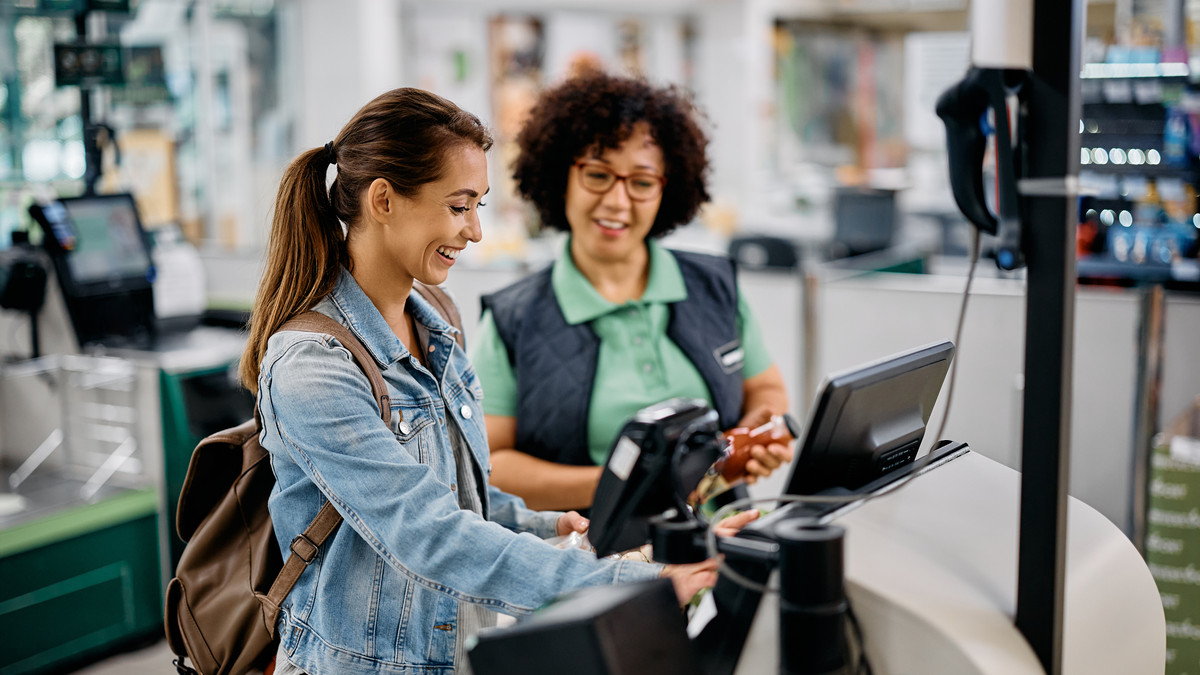My local grocery store has had an off-and-on relationship with self-checkout machines.
For a while, the PCC Community Markets location in Seattle had a small bank of kiosks positioned at the store’s front end. But it took those kiosks out after a few years, noting that customers preferred the personal touch of having a cashier scan and bag their items.
Then, in 2021, spurred in part by rising demand for contactless checkout options, PCC brought self-checkout kiosks back to all of its stores, where they’ve been ever since.
I’m happy it ended up this way, because I’m a shopper who uses either option depending on my needs. If I’m buying more than 10 items, and especially if I’m buying produce, I like to use the traditional checkout lane, where a staff member can ring up those bagged carrots or that head of lettuce with just a few keystrokes. But if I’m only popping in for a grab-and-go lunch or a fill-in trip, I like to visit the “Express” checkout area. Knowing that I have both of those options makes me want to shop at this store more often.
Self-checkout is by no means perfect. It’s too hard to key in produce and loose items like baked goods. Too often, barcodes won’t scan. And having to wait on customer service can be a pain.
But I appreciate having an alternative to the traditional staffed checkout lane, and I think a lot of other people out there do, as well, despite all the derision consumers seem to pile onto self-checkout via social media. According to a report released late last year by shopper intelligence firm Catalina, consumers who use both self-checkout stations and staffed checkout lanes consistently have the highest retention rates.
Shoppers are looking for alternatives to standing in long lines at what’s often the end of a long work day, when they just want to get what they need and get home. And they’d probably be open to using another tech-forward checkout option, provided it’s a good experience that doesn’t add time and mental or physical energy.
I’d like to think that it’s because of these reasons that self-checkout kiosks have exploded across the grocery industry in recent years, and why grocers are now trialing scan-and-pay programs, which allow shoppers to log items and pay via a dedicated app or store scanner, and smart carts, which are essentially self-checkout machines rolling around stores.
As someone who covers the space day in and day out, however, I know that operational pressures are also pushing grocers toward more of a self-service model for stores.
Retailers are still struggling to find and retain workers for the front end and other areas of the store. They’re also under considerable pressure to keep prices down right now while still investing in pricey digital technology in a low-margin, rapidly evolving industry. That push-pull of consumer expectations is motivating retailers to look for ways to automate jobs and processes where they can.
Self-service checkout technologies could eventually end up saving grocers a lot of money while also offering shoppers a good experience. But the options out there all have their limitations, making it difficult to know what, if any, new services grocers should bring into their stores — and how to measure success if they do.
As retailers look beyond self-checkout machines to new options like smart carts and even fully frictionless technology, here are a few questions they should consider.
What’s the Customer-Service Plan?
Retailers have to do more than just install self-service checkout options in their stores. They need to have a customer service plan in place to address shopper questions, and to help educate customers on how to use the new services.
When grocers decide to install self-checkout kiosks in their stores, they need to ensure those machines are easy to use, that there’s a strategy in place to fix them when they break down and that employees are close at hand to address any questions, check IDs when needed and more. These employees should be dedicated to the self-checkout area — don’t ask cashiers to pull double duty
Stores that see a lot of shoppers, or that serve a lot of young, tech-savvy consumers, may be good candidates for trialing a scan-and-go app or a smart cart. Here again, it’s important to have a service plan in place. Make sure any new services comes with clear instructions, and have dedicated employees on hand (at least to start) who can walk customers through the process.
If checkout technology isn’t meeting company benchmarks for success, retailers need to ask: Is it the technology, or is it the customer service strategy? Or is it both?
Is It Secure?
Store theft — both intentional and unintentional — has been a major headache for self-service checkout systems. It’s the reason Wegmans a few months ago, and it’s an ongoing concern for retailers that use self-checkout kiosks.
Grocers will need to stress test every new checkout technology they deploy to see if the security features can limit shrink to acceptable levels. Do smart carts accurately tally every item in the basket? Can they be stolen from stores or rolled out into the parking lot where cars might run into them?
Scan-and-go systems have traditionally relied on randomly auditing shoppers as they leave the store — a process that has clearly encouraged shoplifters to test their luck. But these programs claim they can now do more to target suspicious behavior, making audits a bit less random.
Elevated shrink may be something grocers have to live with if their shoppers like having self-service checkout tools. But after shrink hits a certain level, retailers will need to shutter the program, and they should know what that point is.
How Does the System Connect Online and Throughout the Store?
Stores are increasingly going digital. Technology that’s able to track shopper movements, quickly update price tags and so on is showing up in more stores, and it’s all connecting up to create a seamless shopping experience while also improving efficiency and feeding valuable data to companies.
How will kiosks, scan-and-go programs and smart carts plug in with these systems? Offering a better checkout experience for shoppers alone may not be enough at a time when loyalty is moving to omnichannel and operations are increasingly focused on data and incremental revenue opportunities.
There are signs that checkout technology companies are thinking along these lines. Smart cart makers at the recent NRF Show in New York touted their ability to serve up advertising and promotions to customers while they shop. Instacart’s Scan & Pay solution, meanwhile, is part of a system that supports list-building and shopping functionality across online and in-store visits.
Given that self-service checkout programs can alleviate pressure on staffed registers, is it worthwhile to encourage their use in novel ways? Grocers could incentivize usage of scan-and-go programs by offering bonus loyalty points, extra coupons or other ways of gamifying the experience.
Are You Thinking Ahead to Frictionless?
Due to cost and technology constraints, fully frictionless checkout technology isn’t really viable right now for grocery stores that aren’t owned by Amazon.
But those barriers are going to come down over time as the technology evolves, and within several years this option will likely join the ranks of self-service checkout programs that grocers can choose to implement in their stores. Considering this, retailers should start thinking now about whether they’ll want to implement a frictionless system, and what they’ll need to do to make it stand out from the competition.
In addition to a faster, more seamless shopping experience, checkout systems that utilize AI and computer vision claim they can deliver valuable shopper metrics to retailers as well as eradicate store theft by charging shoppers for every item they have on them when they leave a store.
However, as Amazon Fresh’s recent struggles show, frictionless technology is not going to boost spending and shopper loyalty on its own. There are also concerns around access and equity that these systems have to account for, like how to welcome shoppers who may not have a credit card or loyalty account, or who simply don’t want to use one of these high-tech systems.
Grocers may also want to avoid the hardware-heavy approach that’s on display at Amazon Fresh and Whole Foods stores that feature Just Walk Out technology. Those entrance gates can make a store feel like a subway station, and all those cameras hanging from the ceiling make it all too apparent that you’re being closely watched.
This article was written by Jeff Wells from Grocery Dive and was legally licensed through the Industry Dive Content Marketplace. Please direct all licensing questions to legal@industrydive.com.
![]()



